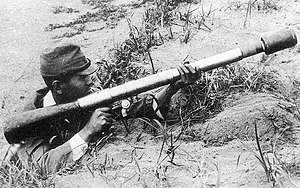Type 5 45mm bazooka
| Type 5 45mm bazooka | |
|---|---|

|
|
| general information | |
| Military designation: | Type 5 45mm bazooka |
| Development year: | 1945 |
| Manufacturer country: |
|
| Production time: | 1945 |
| Weapon Category: | Panzerfaust |
| Furnishing | |
| Overall length: | 1000 mm |
| Weight: (unloaded) | 6.4 kg |
| Barrel length : | 600 mm |
| Technical specifications | |
| Caliber : | 45 mm |
| Ammunition supply : | individually |
| Lists on the subject | |
The Type 5 45 mm bazooka ( Japanese 試製 五 式 四 十五 粍 簡易 無 反動 砲 Shisei go-shiki shijūgo-miri kan'i muhandōhō , dt. "Experimental type 5 45 mm simple, recoilless firearm"), too Experimental Type 5 45mm Panzerfaust , was a Japanese reactive anti-tank rifle . The term type 5 refers to the year of introduction within the Japanese calendar scheme in 2605 - in the Gregorian calendar the year 1945.
history
In the course of the Pacific War , the Imperial Japanese Army found itself increasingly exposed to the situation that it had no effective anti-tank defense against enemy tanks . The Type 1 37 mm - and type 1 47 mm - anti-tank guns proved under favorable conditions to be effective against light tanks such as the M3 Stuart , however, were against stronger models like the M4 Sherman almost powerless. In search of alternatives, the Type 99 mine was introduced as a weapon against tanks and vehicles as early as 1939 . Since the Imperial Japanese Navy had priority in armament projects and the allocation of resources , the army was forced to fall back on existing anti-tank equipment. It was not until 1944, in view of the successful Allied offensives, that the army command felt compelled to make more powerful anti-tank equipment available to the infantry as quickly as possible. At the end of 1944, the Type 4 7 cm anti-tank rifle was tested, which, although it had good penetrating power, had to be operated by two men and weighed up to twelve kilograms.
At the beginning of 1945, in anticipation of an Allied landing on the Japanese mother islands, the army command looked for a lighter and cheaper anti-tank solution. The Type 5 45 mm Panzerfaust was developed, which was roughly similar to the German Panzerfaust 30 in terms of range and penetration power . Production of the Type 5 began in early August 1945.
technology
Type 5 consisted of a 600 mm long, 53 mm thick steel tube with an inside diameter of 45 mm. The pull-off device was located at one end of the steel pipe. Directly in front of this a 10 cm short tube could be inserted, which carried a kind of pistol grip. The conical rear part, from which the jet of fire of the propellant charge emerged , could be inserted at its end . A 700 mm long rod pushed into the tube at the front contained the propellant charge for the shaped charge , which was inserted in a cylinder measuring 80 mm in diameter (length approx. 15 cm). The propellant charge was triggered by a modified 7.7 mm cartridge containing 1 g of smokeless black powder and the propellant charge, consisting of 100 g of propellant charge, triggered. To fire the Type 5, the firing pin of the trigger was cocked manually, the safety was released and the trigger was pulled. The projectile had a maximum muzzle velocity of 40 m / s. The effective range was approx. 30 m (5 ° firing angle) and could penetrate up to 100 mm of armor. With a firing angle of 45 °, a maximum range of approx. 150 m could be achieved, whereby the hit accuracy dropped drastically. When loaded, the Type 5 weighed 8.7 kg and could be operated by one man.
Technical specifications
- Caliber: 45 mm
- Pipe length: 600 mm
- Length with warhead: 1000 mm
- Weight: 6.4 kg
- Bullet weight: 2.3 kg
- Muzzle velocity V 0 = 40 m / s
- Effective range: 30 m
- Maximum range: 150 m
- Penetration: 100 mm
literature
- Leland Ness: Guide to Japanese Ground Forces 1937-1945: Volume 2: Weapons of the Imperial Japanese Army & Navy Ground Forces Helion & Company, 2014, ISBN 978-19099-8275-8 .
Web links
- Experimental AT Guns. Taki's homepage, accessed on February 8, 2016 (English).